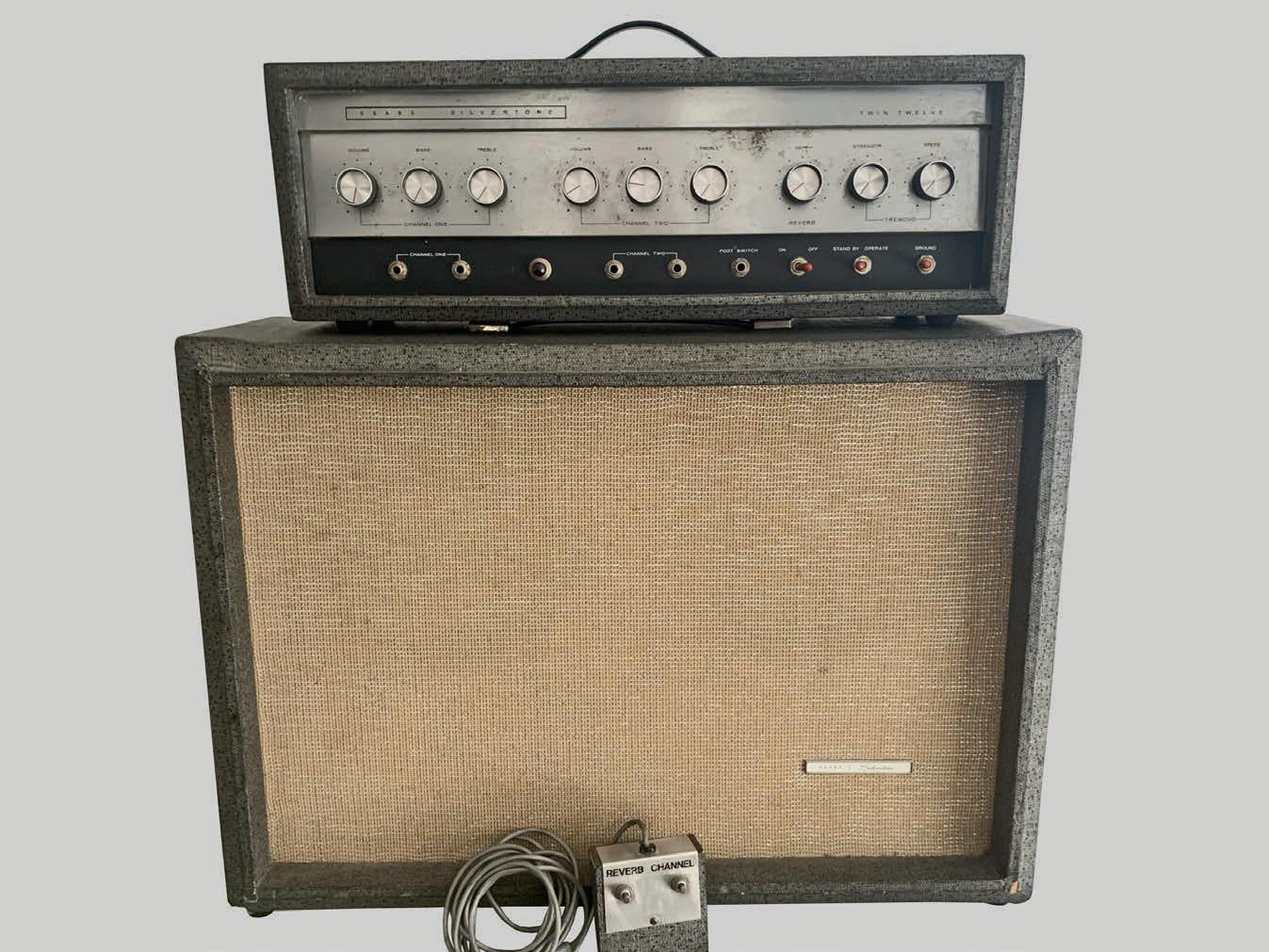
I bought my first electric guitar in 1962, at the age of 14. It had no brand name, not even a Sears-Roebuck or Montgomery Ward house brand. It was made of poplar, including the neck and fingerboard, and painted an ugly shade of yellow-green. I refinished it with a cherry-red sunburst, shading to a walnut brown on the back and edges and re-strung it. That guitar served for me to learn the differences between playing an electric guitar and playing the Silvertone arch-top acoustic that I had used up to then.
I bought the guitar and an amp for less than half the going price of a Silvertone "starter" electric guitar. The amp's maker was as anonymous as the guitar's maker. The amp itself certainly dated back to the early 1950s, or perhaps even the 1940s, because the tubes were all loctals. If memory serves, it used a 7F7 high-mu twin triode, a 7A5 beam power tube, and a 5Y3GT rectifier. The circuit was similar to that of an early Fender Princeton (Figure 1), except for the tube complement. Maximum output power from a single-ended 7A5 was about 3.3W, which in this case fed an 8" Magnavox speaker. It had one channel, one volume control, and a tone control. No tremolo or reverb. And one other prominent characteristic: hum-lots of hum.
At that point, I had studied Supreme Publications' Radio Servicing Course Book and Van Valkenburg, Nooger, and Neville's five-volume Basic Electronics course commissioned by the US Navy, so I thought that by rewiring the low-level signal path, twisting the filament leads, and adding a hum-balance potentiometer to the filament supply, I could eliminate the hum. Not so: I had yet to learn about common grounding impedance, often mis-called "ground loops," caused in the case of this amp by randomly soldering ground points to the chassis rather than using a single ground point located near the input jack. So I just tried to ignore the annoying hum for two years, until I could afford a better amp.
Bu hikaye audioXpress dergisinin May 2023 sayısından alınmıştır.
Start your 7-day Magzter GOLD free trial to access thousands of curated premium stories, and 9,000+ magazines and newspapers.
Already a subscriber ? Giriş Yap
Bu hikaye audioXpress dergisinin May 2023 sayısından alınmıştır.
Start your 7-day Magzter GOLD free trial to access thousands of curated premium stories, and 9,000+ magazines and newspapers.
Already a subscriber? Giriş Yap

Perspectives on Automotive Sound Design - In the Era of Electric Vehicles
From combustion engine vehicles to fully electric vehicles, and from sound systems in the car to sound design and synthesis for the car itself, everything is changing in the automotive industry. This conversation with two members of the DSP Concepts automotive team with vast experience in the field, John Whitecar, VP of Product Management, and Steve Ernst, Head of Business Development, offers valuable insights on how things are evolving.

Audioscenic: From Vision to Product
Audioscenic is an innovative 3D audio beamforming technology company spun off from the University of Southampton. It is a remarkable example of perseverance, from early development to the first commercial implementation, which audioXpress considered Best of Show at CES 2023. This article shares the story so far, as Audioscenic continues its groundbreaking journey exploring consumer applications for its forward-thinking approach to spatial audio.

The Changing Audio-Ecosystem in Electric Vehicles
The rapid shift to plug-in hybrid and full-battery electric vehicles is having a significant and long-lasting impact on how audio systems are integrated into cars. While some noises are much more prominent due to the absence of the familiar engine noise, the transition offers exciting possibilities for sound systems, passenger entertainment, and enhancing the overall automotive experience.

A (Z)OTL with 300Bs: Part 1-The Makeover
Rebuilding an amplifier for reasons of better reliability, better aesthetics, or bringing it up to the latest standard can be very rewarding. And if it is a classical, technological grandstand, even more so. Thomas Perazella embarked on such an adventure with a famous David Berning ZOTL amplifier. In Part 1 of this article, Tom presents the amplifier and discusses its unique circuitry. In Part 2, he will proceed to dismantle and rebuild the amp for the new owner and place it in a new chassis

The Hypex NCORE NCx500 Amplifier Module
NCORE (NC) amplifier modules are the flagship product from Dutch manufacturer Hypex Electronics and its success among the high-end audio brands is well documented. In 2022, Hypex announced the introduction of its improved NCOREX technology, starting with the NCx500 OEM module, which audioXpress received for review

Monoblock Power Amplifier with Precision Bias Control
In Part 2, Bruce Gillingham discusses the remainder of the MB1's circuitry, its mechanical design, and its performance measurements

A Trip Down Memory Lane
The history of tube application began with radio receivers, the telephone system, and cinema sound systems. Later, tubes began to be used in home stereo systems, and in amplifiers for electric guitars. Today, the primary markets for tubes are high-end stereo and musical instrument amplifiers. In this article Richard Honeycutt remembers his first contact with \"starter\" guitar amps as a teenager, progressing throughout his days as a semi-pro musician

The Vanderveen Trans PP80 Valve Amplifier
This new push-pull (PP) valve amplifier, featuring the Trans technique, delivers 80W power, refined resolution, valve-sound envelopment, and low distortion plus good speaker damping. And... the amp is simple to construct

Accuracy in LTspice Modeling
Sometimes we need to consider the human factor when using circuit design simulation tools. In this article, our hollow-state expert details an error that occurred in a past article, which is now being corrected.

Transitioning Audio Tests from R&D to the Production Line
Production line audio testing poses many challenges such as noisy environments, harsh operating conditions, high throughput, relative limits, and more. In this article, Steve Temme shares his observations and outlines the main considerations to ensure a successful operation.